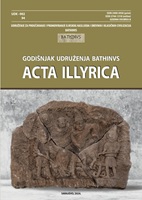Tragovi kraja Aqu(a)e, njene municipalne jedinice i antičkog načina života na sarajevskom području
Traces of Ending of Aqu(a)e, its Municipal Unit and the Ancient Way of Life in the Sarajevo Area
Author(s): Salmedin MesihovićSubject(s): Archaeology, Cultural history, Social history, Ancient World
Published by: Udruženje za proučavanje i promoviranje ilirskog naslijeđa i drevnih i klasičnih civilizacija “BATHINVS”
Keywords: Sarajevo; Aqu(a)e; Late Antiquity; barbarian invasions; Early Middle Ages;
Summary/Abstract: In the historiography and archeology of the city of Aqu(a)e, whose eponymous unit of municipal autonomy covered the Sarajevo area, and possibly some other nearby areas, the end of its development in the classical civilization form is a source of doubt. In the available sources, it is still not possible to find explicit proof of the events that led to the end of the city of Aqu(a)e and its unit of municipal autonomy. Certain indications link the end or rather the beginning of the end of the city of Aqu(a)e to the wars with the Goths in the last two decades of 4th century, perhaps with intrusions in the period AD 378-380. However, if the Goths, and other barbarian and provincial groups which joined them, occupied Aqu(a)e in this period, this did not mean the end of antiquity in the Sarajevo area. During the 5th and 6th century, a late antique way of living developed, relying on forts on the heights, of which Debelo Brdo and Ilinjača on Kotorac stand out in particular. Only the collapse of the Eastern Roman defense in the second and third decades of 7th century introduced the Sarajevo area into a new medieval era in which there was a symbiosis of natives and settlers.
Journal: Godišnjak Udruženja BATHINVS “Acta Illyrica”
- Issue Year: 8/2024
- Issue No: 8
- Page Range: 113-134
- Page Count: 22
- Language: Bosnian

